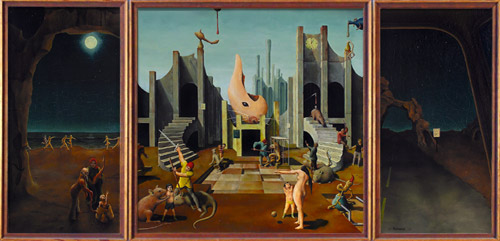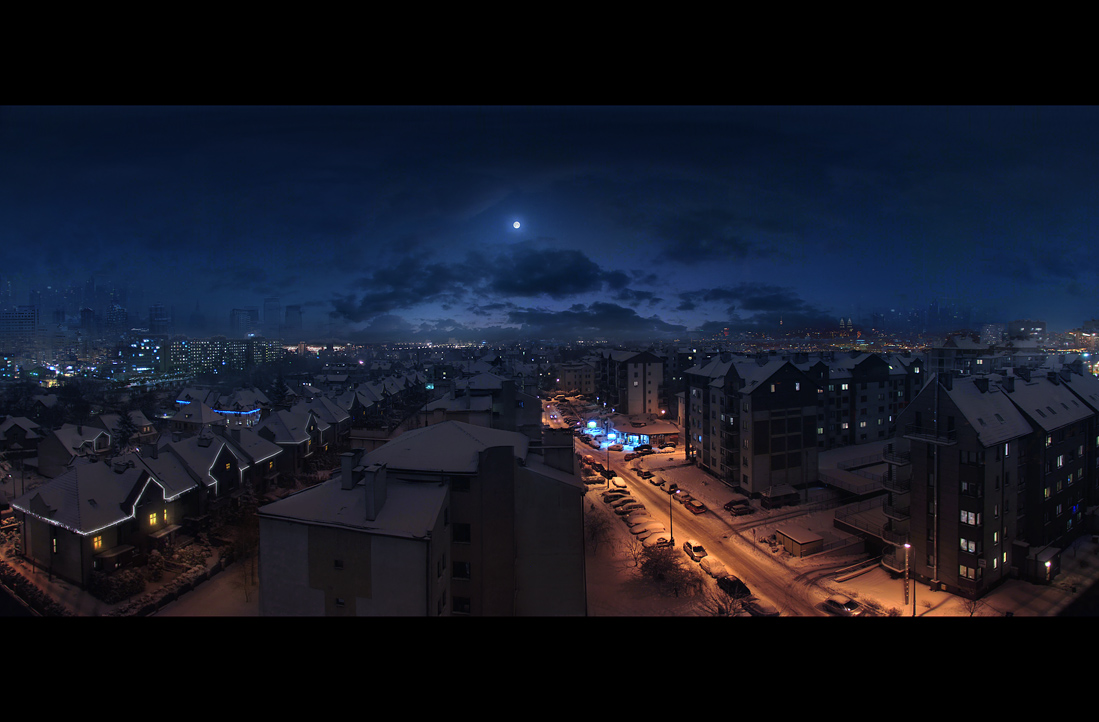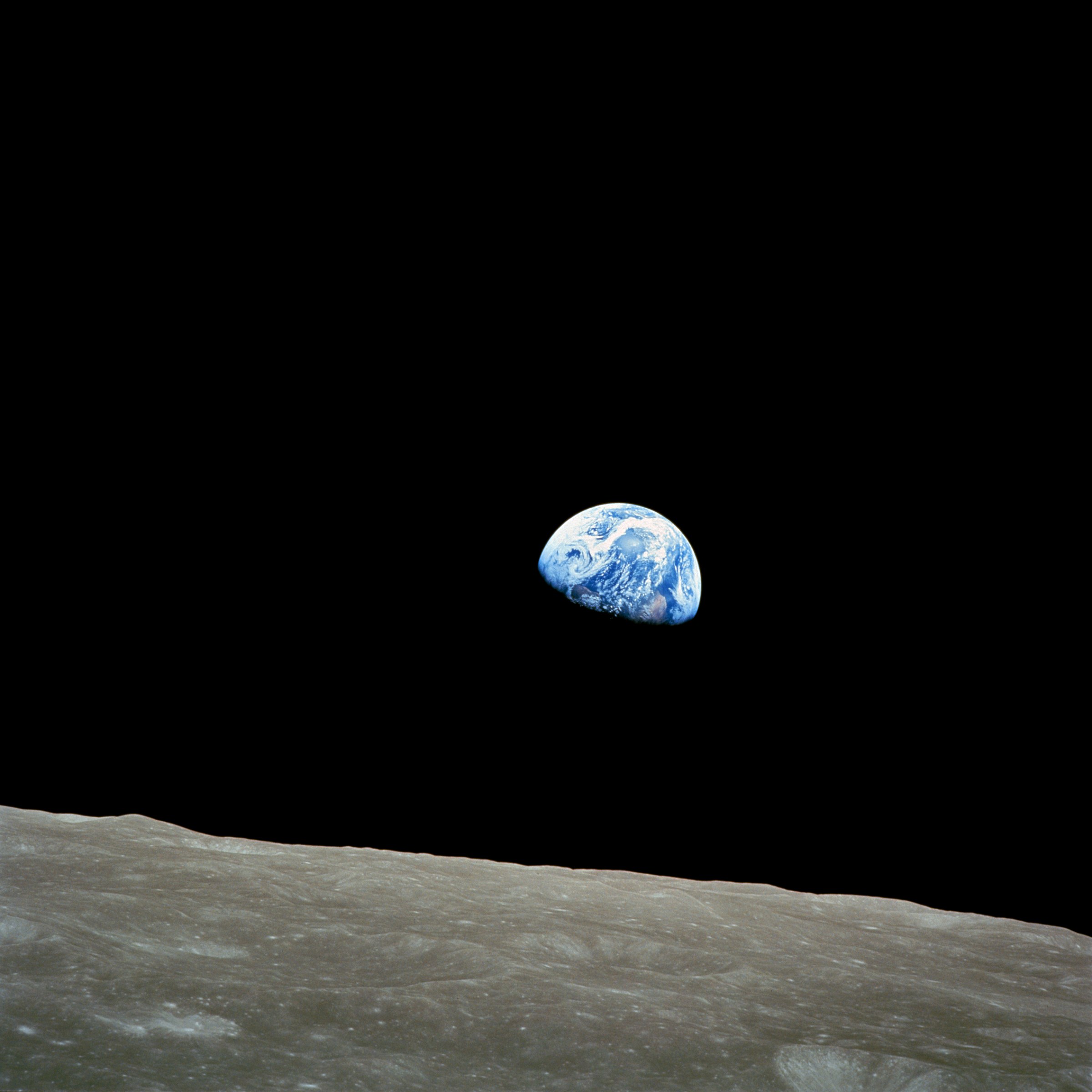 |
| Jim Morrison Triptych - 1971 |
http://tebreitenbach.com/archives/articles/1970-71-Morrison_letters_O.htm
Panel 1: "The left panel depicting a radiant moon-lit beach and an endless stream of young naked couples running silently along the water's edge. On the beach, a tiny infant grins at the universe and around its crib stand several ancient, old people."
According to a Morrison biographer Jerry Hopkins (whose letters can also be found at the link above), this panel was meant to be a variation on a dream Morrison may or may not have had; not a whole lot of info there. Let's see what we can find.
For starters, there are the naked people. They run in couples along the beach, a sense of freedom and a devil-may-care attitude are depicted through their mid-run stances. In the mid-ground, a large rock formation (which looks structurally similar to the one farther off in the distance in panel 3) creates a plane, separating them from the aforementioned infant and ancient, old people.
What is interesting to note about the placement of all these people is how clearly separated they are, and not just by the rocks. There is a break in the string of naked people directly above the infant and its elders, which leads directly up to the moon. This shows a very clear distinction between the two worlds of these various people. The people running are the free spirits: uninhibited, enjoying all they can of nature and its wonders. While the infant and elders represent the dreamers: always looking onward to bigger and better things, better worlds; straight from birth they are taught to look for more.
Panel 2: "The center, a modern city or metropolis of the future at noon, insane with activity."
Jerry Hopkins' take on this panel is that it is "an extension of [Morrison's] interest in chaos and insanity."
In this panel, we can see many things happening. What exactly is happening is a challenge unto itself. In a very abstract way, this panel could serve as a parallel to the human brain.
NOTE: When I say "frame left" or "frame right" in the following paragraph, I mean the left or right side (respectively), facing outward from the painting. So to the viewer, "frame left" means their right, and vice-versa.
To the left of the image (frame left) we can see the representation of the left side of the brain: the analytical side. In the background, large, straight structures pierce the sky just behind a large, stone structure. On this structure hangs a clock, symbolizing organization and order, fixed firmly at 12:05.
In the tableau beneath this, we can see a monkey, a symbol of spontaneity being held in a cage and prodded by a man with a stick; here, creativity is held captive and taunted by logic and order.
In the foreground, a boy receives a lesson in the forces of gravity. The other people cluttering this space represent the necessity for logical perceptions to be bolstered by the logical perceptions of others; things like scientific observations and hypotheses.
The rats, representing the pestilence and dirtiness of reality are allowed to roam freely, without interruption; the objective worldview of the left brain gives an uncompromising look at one's surroundings.
Frame right (the creative brain) in some ways mirrors frame left, but has its share of differences. For example, instead of large, polygonal structures rising through the sky, we see an abstract, fishlike shape rising from the center of the image, but leaning more towards frame right. Even the stone structure (noticeably lacking a clock) is arranged in a much less orderly way, seemingly in a state of disrepair.
In this portion of the frame, people are almost entirely absent. The only people around are a small boy playing with a monkey, much like the caged one on the other half of the frame; a man with a spear and sword slays one of the giant rats, closing the brain off from the tragic, realistic world outside, while another rat assaults a small boy nearby: the dirty outside world attacking the youth-like innocence of creativity.
Panel 3: "The last panel, a view through a car windshield at night on a long straight desert highway."
Jerry Hopkins posits: "The final panel refers to a scene from his childhood when [Morrison] and his father came upon an overturned truck, dead and injured Indians scattered 'on dawn's highway bleeding.'"
Well, we have a bit more info now. So how do we get to an image of a blank stretch of road from "dead and injured Indians 'on dawn's highway bleeding?'" I feel the most likely answer is that this dark stretch of pavement represents the pursuit of the unknown. Jim Morrison and his father had no idea that they would run into an overturned truck littered with dead bodies that night. They were just driving, like anyone else could have been.
Through that rocky arch in the mid-ground could lie anything. The world beyond is featureless, holding infinite possibilities. The rocky, mountainous horizon represents the varying multitudes of possibilities that lay ahead.
My Opinion
I quite like this triptych. The compositions are a bit flat for my taste, but for a fan of The Doors as I am, they provide an interesting look into frontman Jim Morrison's thought process. With the vaguest suggestions of scenes by Morrison, Breitenbach was able to create three rich, cerebral pieces of surrealist artwork that come together to form a collective whole. The best part about it (and arguably all of surrealism) is that everything I wrote above could be completely wrong. But it also doesn't matter. What matters at the end of the day is that you have an interpretation of what you've seen; something resonated enough in your brain to make you dig deeper into the work and find more than you thought you could.
Phew. This was a long post, wasn't it? But it's over now! I'll see you all next time! We're officially in the 70s now!





